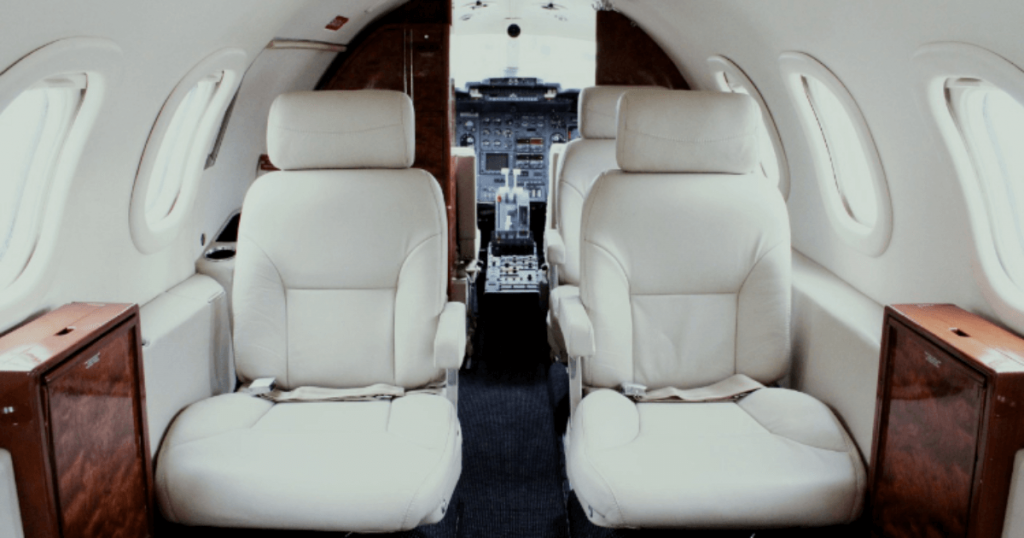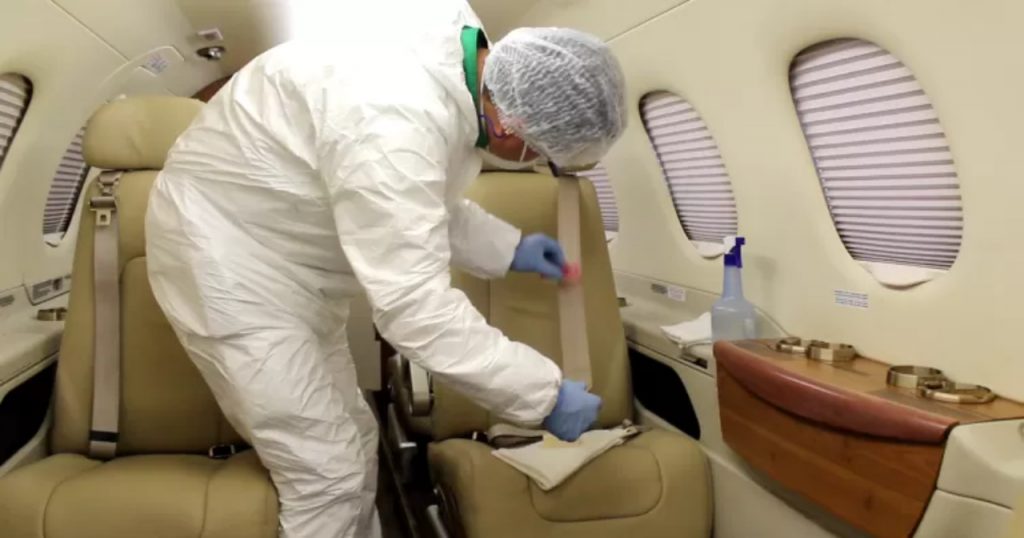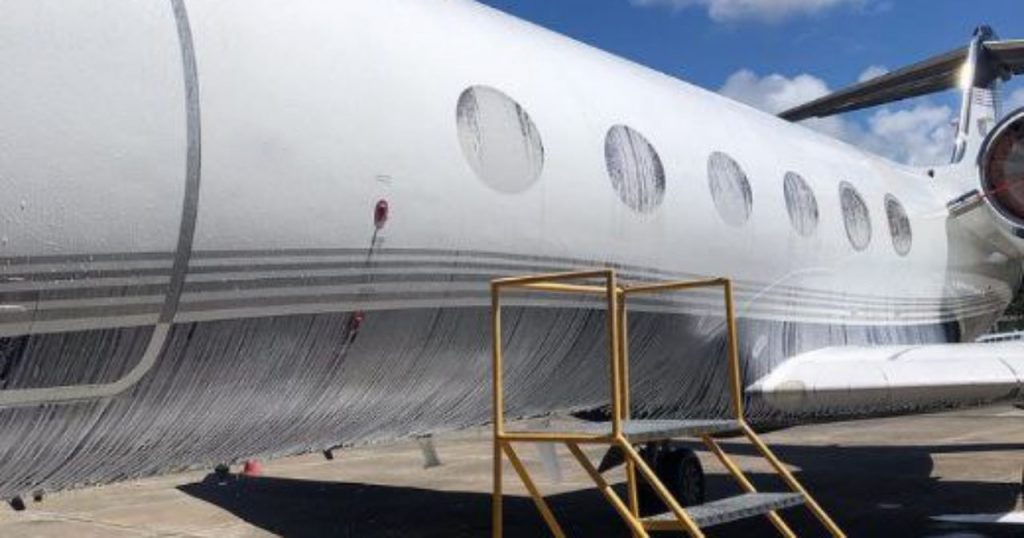Switch to:
 EN
EN  Português (PT)
Português (PT)  Español (ES)
Español (ES)
On any trip booked with Flapper, when you arrive at your departure point and board the chartered aircraft, you will find equipment in perfect flight condition: clean, organized and comfortable, so that your itinerary is carried out with the best experience possible in executive aviation. In this article, we describe how the cleaning process for an executive aircraft is carried out.

Learjet 35A Interior
Until the moment arrives of a passenger boarding an aircraft, much has already occured in an operation that involves many hands… from our city managers, representatives of partners and aerodromes, to the flight team. But, in addition to the main functions that come to mind when we think about this chain, there is a team just as fundamental: that of cleaning.
In executive aviation, the workers who take care of aircraft cleaning perform a silent, agile, and effective service, ensuring that there is no residue from the previous flight when a new customer boards.
What already required a routine of excellence, in fact, gained even more relevance since the Covid-19 pandemic, which showed us the importance of sanitizing not only personal, but also the working environment.
Cleaning Routines
First of all, it should be noted that aircraft cleaning is done with specific products for aviation, both executive and commercial. These materials are designed not to harm the complex structure of jets and helicopters, without humidifying electronic compounds, increasing the risk of ignition, or exposing the environment to toxic gases.
And when are aircraft sanitized? The National Health Surveillance Agency (Anvisa) recommends that sanitation occur at each stop – in transit or overnight – in order to ensure a safe environment so as to not endanger the health of travelers or other people who use the equipment.
At Fly Clean – Aeronautical Aesthetics, the recommendation is followed: the company conducts cleaning after each flight – or during periods of a longer stay in the hangar. As Júnior Mendes Caldeira, Operational Safety manager explains, the company has different types of sanitation. The most regular is called “complete cleaning”, while the “detailing process” corresponds to a more complete and, consequently, more complex process. The team also works with “conservation cleanings”, which serve to maintain the aircraft in aesthetic terms.
Normally, when cleaning is done in transit, the ideal is to focus on mitigating the risk of disease transmission, both in post-disembarkation and pre-shipment. Sanitization and disinfection are carried out, above all, in areas with multiple surfaces – tables, armchairs, backrests, windows, door handles, luggage compartments, lighting equipment, etc. – and surfaces in critical areas such as bathrooms and galleys.
When the aircraft is parked overnight (or in storage), it’s time to take advantage of the time for a more thorough cleaning. Thus, in addition to everything that is done in a shorter sanitization, the work has a broader scope. That is, also cleaning floors, rugs, carpets, fabrics, and the interior areas of luggage compartments and galleys.
It is essential to highlight that, regardless of how deep the cleaning is, employees always use personal protective equipment (PPE), such as aprons, gloves, glasses and, among others, masks. Thus, not only customers are protected, but also the sanitation team, which is trained on the correct way to use PPE and on the dress code.
Internal cleaning
One of the most critical places in terms of internal dirt, in constant contact with shoes and suitcase wheels, are carpets and rugs. Unlike what we do in our homes, in business aviation it is not recommended that these materials be swept. This can lead to the suspension of dust particles, contaminating environments that have already been sanitized or affecting the aircraft’s air conditioning system.

Image: Alexandre Saconi/UOL
More appropriately, vacuum cleaners with HEPA filters – highly efficient – are used to remove dirt from these carpets and fabrics.
In addition to the sanitization of carpets and rugs, according to Caldeira, the main procedures carried out in internal cleaning focus on sanitizing all leather and upholstery parts, detailed sanitizing of the cockpit, cabinets, and galley and the windows and chrome parts of the interior of the aircraft.
These processes require care, as the sensitivity of equipment in the cockpit or galley demands attention. When cleaning, for example, the pilot panel, where there are several electronic controls, the attention to absolute detail must be redoubled.
“The care of each component is of paramount importance, as they are high value equipment and we must always keep them in perfect condition”, says the Fly Clean manager.
The armchairs where we sit, because of the delicacy of the material, are rubbed with products previously applied to cloths. The direct contact of chemicals with the leather has the potential to damage the seats, so it is important that the procedure is done correctly.
Then, to remove the excess, dry cloths are used. This process is also repeated on surfaces such as tables. It is a way to ensure that no more product remains in the environment than necessary, and that cleaning takes longer. This is because, when passing a dry cloth over the newly sanitized surface, a protective film is created in the region, which lasts for days.
Due to the pandemic, some companies started to spray disinfectant on aircraft. In these cases, special spraying machines are used. They do not allow wet particles to remain suspended and damage structures. The teams also spray the product into the air conditioning pipes, which remain connected throughout the entire process.
At Fly Clean, disinfection is done using an atomic nebulizer. “We use certified products for the process, always following the standards of Anvisa and the manufacturer of each aircraft. With the pandemic, the cleaning of aircraft was a point of increased attention, as we were dealing with a fact that was initially unknown and we needed to adapt to the processes as soon as possible”, says Caldeira.
External parts
On the outside of aircraft, sanitation is more important than we assume. A clean surface means less friction with the air. This, in turn, results in less fuel consumed and a greater perception of safety on the part of passengers during the journey.

Instagram FlyClean
Therefore, normally, the underside of the planes is the last to be cleaned, both so as not to spread the dirt that accumulates in the region where it has already been sanitized, and to pay attention to this very important place.
Anyway, on the outside, cleaning is done dry or with products intended for aviation, depending on the flight schedule and the time dedicated to cleaning. Regardless of the extent of cleaning, brushes, sponges, and soft surface cloths are used so they do not scratch or damage the aircraft paintwork.
Fly Clean works with a few different options. “In traditional washing, we use water, but with a safer cleaning method, in which precaution and care with the paint are paramount. In dry cleaning, the aim is to avoid corrosion and water accumulation in parts that are difficult to access”, explains the manager.
According to Caldeira, the company also works with monthly technical waxing – which creates a protective barrier to preserve the aircraft – with polishing of chrome surfaces and detailed cleaning of the landing gear, flaps, and command surfaces.
Finally, the windows are scrubbed very carefully. Many cleaning teams choose to carry out this cleaning with unidirectional movements – horizontal or vertical, the opposite of the direction used internally. With this “crossover”, if any dirt remains, it will be easier to see which side it is on.
Air taxi chartering with Flapper
Now that you know how our partners are dedicated to cleaning available aircraft, how about planning your next leisure or business trip with Flapper? On our website or app, you can find instant quotes and the best options for you.
It is possible to customize: arrival and departure aerodromes, schedule, and aircraft models. There are several options for national and international charters, always with our guarantee of cleanliness, comfort, convenience, safety, and agility.
Get in touch with this team by WhatsApp or phone by:


